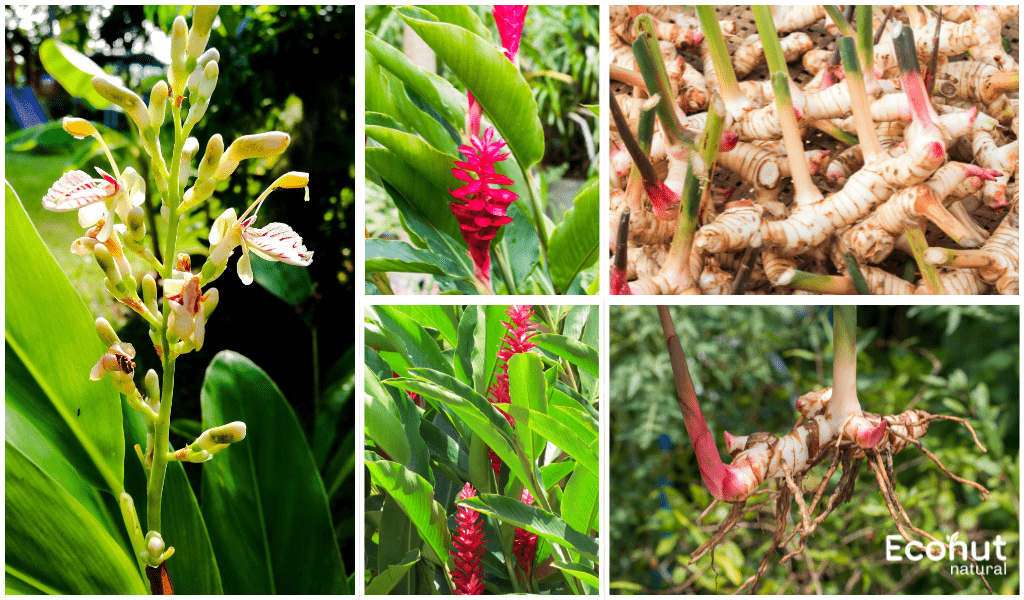Rasna, also known as Alpinia galanga, is a perennial herbaceous plant that reaches a maximum heightheight of 3–4 meters. This plant has creeping branches that are covered in a bundle of leaves. This plant has long, broad leaves that taper to small points. The leaves are a dark green color.
This plant’s rhizome is roughly 7 cm long and has a light yellow or reddish hue. This plant produces greenish-white, roughly 3-cm-long flowers. The plant flowers in May and June, and it bears fruit in August and September. Its fruits are reddish-orange in hue and resemble little cherries.
Description
This herb is used medicinally to treat a variety of digestive and respiratory issues in young newborns. The plant’s seeds combat oral bacteria and other tooth cavities. It works as a powerful laxative, boosts digestion, and improves hunger. This herb’s essential oil is used to lessen inflammation in the body’s joints and nervous system.
Botanical Name:
Alpinia Galanga
Family:
Zingiberaceae
Leaves:
Alpinia galanga is a plant with alternating, distichous, oblong-lanceolate leaves. Their maximum length is 45 cm, and their maximum breadth is 11.5 cm.
Flowers:
Alpinia galanga has greenish-white, roughly 3-cm-long Flowers. They bloom between May and June and develop in thick panicles.
Fruits:
Alpinia Galanga yields orange-red fruits in August and September following flowering.
Stems:
Alpinia galanga’s aerial stems are actually pseudostems made of rolled leaf sheaths. These upright, green stalks have a maximum height of 3.5 meters.
Habitat:
Basically, Alpinia galanga is indigenous to South Asia and Indonesia. Due to its commercial value and range of health advantages, this advantageous plant is also grown in Malaysia, Thailand, Sri Lanka, and Myanmar. It is found over the Himalayas, Bihar, Assam, and West Bengal in India. It grows where there is enough sunlight and precipitation.
Dosage:
- Powder – 3 to 6 gm
- Decoction – 40 to 20 ml
Chemical Constituents
neolupenol, hexacosanoic ,tetracosanoic acid, triacontanol, stigmasterol, and beta-sitosterol-D-glucoside.
Sanskrit Synonyms
sursa, rasna, rasa, rasna, yukatrasa, elaparni, sugandha and shreyasi
Other Language Names of Rasna (Alpinia Galanga)
Malayalam name – Aratta
Marathi name – Kosht-kulinjan
Philippines name – Langakawas
English name – Thai ginger, Siamese ginger, Greater galangal
Sanskrit name – Dhumala, Dhumparastma
Hindi name – Bara kulanjan
Manipuri name – Kanghu
Kannada name – Dhumarasmi
Tamil name – Aruttai
Urdu name – Kuknjan
Scientific Classification
| Kingdom | Plantae (Plants) |
| Subkingdom | Tracheophyta (Vascular plants) |
| Superdivision | Spermatophyta (Seed plants) |
| Division | Magnoliopsida (Flowering plants) |
| Class | Zingiberales (Ginger order) |
| Genus | Alpinia |
| Species | Alpinia galanga (L.) Willd |
Ayurvedic Properties
Rasa (Taste) – Katu, (Pungent)
Guna – (Qualities) – Laghu (Laghu for digestion), Teekshna (Strong), Ruksha (Dry in nature)
Vipaka – Katu (Undergoes Pungent taste after digestion)
Veerya – (Potency) – Ushna (Hot)
Karma (Actions) – Kaphavata shamaka (reduces vitited kapha and vata dosha)
Rasna (Alpinia Galanga) Uses
- Used to treat rheumatoid arthritis and Vata issues
- Utilized to treat digestive disorders such as indigestion, bloating, colic, abdominal discomfort, and flatulence
- Rasna is highly effective in treating disorders of the female genital system, such as dysmenorrhea and amenorrhea.
- In addition to reducing inflammation, rsana nourishes the skin and tissue layers.
- Rasna leaves have digestive, analgesic, and antipyretic properties.
- Because of its anti-toxic qualities, it purifies blood and lowers blood toxicity.
Rasna (Alpinia Galanga) Benefits
Relieves joint pain:
In Ayurveda, Vata imbalance is the primary cause of joint discomfort. Joint and bone pain can be relieved by rasna or its oil. Rasna helps relieve joint pain because of its analgesic, antipyretic, and Vata-balancing qualities.
Treats Cough and Cold:
Rich in plant-based components with potent Ushna (heat-inducing) and Kapha dosha-balancing properties, rasna helps relieve respiratory conditions like bronchitis, asthma, coughing, and colds. Rasna leaf extracts are also helpful in treating fever and sinusitis, controlling body temperature, and getting rid of excessive mucus from the lungs and upper respiratory tract by clearing the nose and throat passages.
Treats fever:
Rasna can help regulate fever because of its antipyretic qualities, which assist lower body temperature and relieve excessive fever.
Pacifies Muscle Spasms:
There is an abundance of antispasmodic components in rasna leaf extracts. These residues derived from plants help to release taut tissues, relax smooth muscles, and promote flexible muscular functioning. Additionally, rasa has analgesic qualities that significantly reduce muscle discomfort, soreness, and inflammation.
Heals wound:
Rasna (Alpinia Galanga) has anti-inflammatory, antifungal, and analgesic qualities that speed up the healing process of wounds by increasing the pace of wound contraction.
Helpful in diabetes:
Rasna helps with diabetes because it has components called flavonoids that are inherently antioxidant. These antioxidants decrease blood sugar levels and boost the synthesis of insulin.
Relieves muscle spasms:
Rasna’s antispasmodic and analgesic qualities help to calm smooth muscles, which makes it beneficial for treating muscular spasms.
Don’t miss: Vijaysar, Malabar kino (Pterocarpus marsupium)-Uses, Benefits & Side Effects
Rasna (Alpinia Galanga) Side Effects
Upset Stomach:
Rasna can induce indigestion, nausea, and vomiting if taken in excess. To prevent these problems, it’s critical to adhere to prescribed dosages.
Pregnancy and Breastfeeding:
It is advisable to stay away from Rasna if you are pregnant or nursing because there is not enough study on the topic.
Dosage Matters:
It’s critical to take Rasna at the recommended dosages in order to reduce the possibility of negative effects. Always heed the instructions on the product label or the guidance of a licensed Ayurvedic practitioner.
Conclusion
Indigestion can be treated by inducing vomiting with a paste made from a 10cm long rhizome. Additionally, vomiting can be induced with 1-2 grams of leaf powder to help the body expel Kapha dosha. In order to cleanse the blood and eliminate impurities, it is used as a rasayana.
FAQS
What advantages does the herb rasna offer?
Rasna’s anti-inflammatory and analgesic qualities help to relieve joint pain and inflammation, making it useful in the management of arthritis. Because of its antioxidant qualities, it is also beneficial to the kidneys as it lessens oxidative stress.
When is the ideal moment to consume Rasna?
You can drink Rasna beverages while working out. It facilitates the body’s absorption of vital minerals, vitamins, salt, and energy.
What adverse effects does rasna have?
When Rasna is used in accordance with approved dosages, no negative side effects have been documented. But too much of this herb can cause indigestion, nausea, and vomiting, so it’s important to take rasna-based ayurvedic formulations exactly as directed by your doctor.
What advantages does galangal provide for your health?
Additionally, galangal has been demonstrated to possess antifungal and anti-inflammatory qualities, which means that it helps the body fight off bacteria and harmful microbes while also reducing inflammation that causes joint discomfort.

